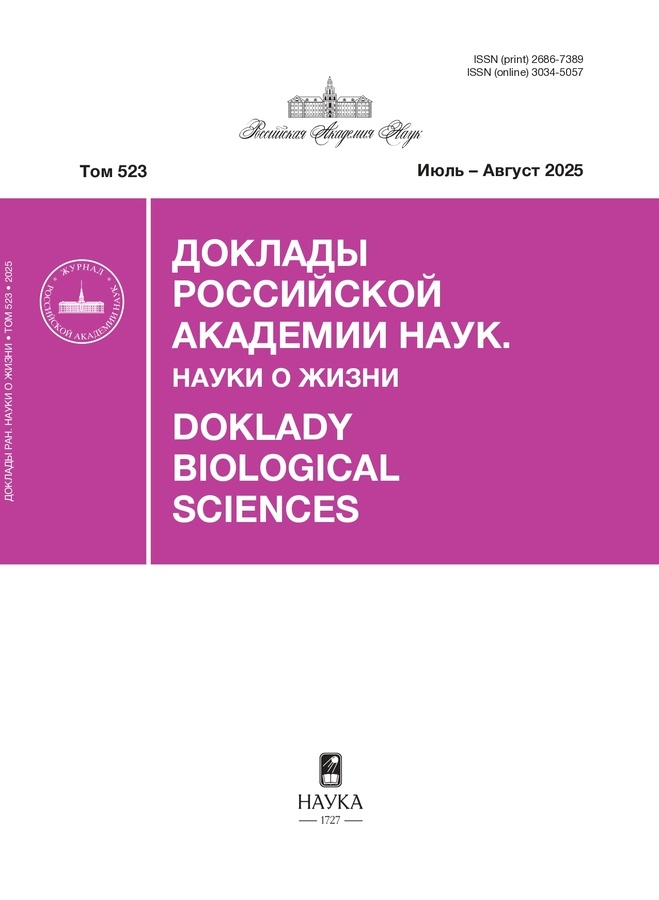Protein complementation approach for quantitative and qualitative analysis of hTERP in cell
- Authors: Shamonova M.A.1, Koriagina M.S.1,2, Shliapina V.L.2, Dontsova O.A.1,2,3,4, Rubtsova M.P.1,2
-
Affiliations:
- Lomonosov Moscow State University, Department of Chemistry
- Shemyakin-Ovchinnikov Institute of Bioorganic Chemistry of the Russian Academy of Sciences
- A. N. Belozersky Institute of Physico-Chemical Biology
- Skolkovo Institute of Science and Technology, Center for Molecular and Cellular Biology
- Issue: Vol 523, No 1 (2025)
- Pages: 439-445
- Section: Articles
- URL: https://medjrf.com/2686-7389/article/view/693504
- DOI: https://doi.org/10.31857/S2686738925040107
- ID: 693504
Cite item
Abstract
The study of protein functioning in a cell cannot be performed by analyzing their content in the cell. The most commonly used method of analysis, western blotting, cannot always be used due to the impossibility of obtaining antibodies that specifically recognize the protein of interest. At the same time, western blotting is a semi-quantitative method of analysis and does not allow determining the exact content of protein in the cell. In this work, we used the protein complementation method for the qualitative and quantitative assessment of the hTERP protein content in the cell. Using genome editing, a HiBiT appendage was introduced to the C-terminus of the hTERP protein, the complementation of which with LgBiT restores active luciferase. As a result, we determined the hTERP protein content in the HEK293T cell line.
About the authors
M. A. Shamonova
Lomonosov Moscow State University, Department of Chemistry
Email: mprubtsova@gmail.com
Moscow, Russian Federation
M. S. Koriagina
Lomonosov Moscow State University, Department of Chemistry; Shemyakin-Ovchinnikov Institute of Bioorganic Chemistry of the Russian Academy of Sciences
Email: mprubtsova@gmail.com
Moscow, Russian Federation; Moscow, Russian Federation
V. L. Shliapina
Shemyakin-Ovchinnikov Institute of Bioorganic Chemistry of the Russian Academy of Sciences
Email: mprubtsova@gmail.com
Moscow, Russian Federation
O. A. Dontsova
Lomonosov Moscow State University, Department of Chemistry; Shemyakin-Ovchinnikov Institute of Bioorganic Chemistry of the Russian Academy of Sciences; A. N. Belozersky Institute of Physico-Chemical Biology; Skolkovo Institute of Science and Technology, Center for Molecular and Cellular Biology
Author for correspondence.
Email: mprubtsova@gmail.com
Moscow, Russian Federation; Moscow, Russian Federation; Moscow, Russian Federation; Moscow, Russian Federation
M. P. Rubtsova
Lomonosov Moscow State University, Department of Chemistry; Shemyakin-Ovchinnikov Institute of Bioorganic Chemistry of the Russian Academy of Sciences
Email: mprubtsova@gmail.com
Moscow, Russian Federation; Moscow, Russian Federation
References
- Levy M. Z., Allsop R. C., Futcher A. B., et al. Telomere end-replication problem and cell aging // Journal of Molecular Biology. 1992. Vol. 225, № 4. P. 951–960.
- Chow T. T., Zhao Y., Mak S. S., et al. Early and late steps in telomere overhang processing in normal human cells: the position of the final RNA primer drives telomere shortening // Genes & Development. 2012. Vol. 26, № 11. P. 1167–1178.
- Fumagalli M., Rossiello F., Clerici M., et al. Telomeric DNA damage is irreparable and causes persistent DNA-damage-response activation // Nat Cell Biol. 2012. Vol. 14, № 4. P. 355–365.
- de Lange T. Shelterin-Mediated Telomere Protection // Annual Review of Genetics. 2018. Vol. 52, № 1. P. 223–247.
- Liu D., O'Connor M.S., Qin J., et al. Telosome, a Mammalian Telomere-associated Complex Formed by Multiple Telomeric Proteins // Journal of Biological Chemistry. 2004. Vol. 279, № 49. P. 51338–51342.
- Harley C. B., Futcher A. B., Greider C. W. Telomeres shorten during ageing of human fibroblasts // Nature. 1990. Vol. 345, № 6274. P. 458–460.
- Allsopp R. C., Vaziri H., Patterson C., et al. Telomere length predicts replicative capacity of human fibroblasts. // Proceedings of the National Academy of Sciences. 1992. Vol. 89, № 21. P. 10114–10118.
- Morin G. B. The human telomere terminal transferase enzyme is a ribonucleoprotein that synthesizes TTAGGG repeats // Cell. 1989. Vol. 59, № 3. P. 521–529.
- Weng N. P., Levine B. L., June C. H., et al. Regulated expression of telomerase activity in human T lymphocyte development and activation // J. Exp. Med. 1996. Vol. 183, № 6. P. 2471–2479.
- Lu W.-Y., Forbes S. J. Telomerase Activity Links to Regenerative Capacity of Hepatocytes // Transplantation. 2018. Vol. 102, № 10. P. 1587–1588.
- Holt S. E., Shay J. W. Role of telomerase in cellular proliferation and cancer // J. Cell. Physiol. 1999. Vol. 180, № 1. P. 10–18.
- Yashima K., Maitra A., Rogers B. B., et al. Expression of the RNA component of telomerase during human development and differentiation // Cell Growth Differ. 1998. Vol. 9, № 9. P. 805–813.
- Rubtsova M., Naraykina J., Vasilkova D., et al. Protein encoded in human telomerase RNA is involved in cell protective pathways // Nucleic Acids Research. 2018.
- Pakhomova T., Moshareva M., Vasilkova D., et al. Role of RNA Biogenesis Factors in the Processing and Transport of Human Telomerase RNA // Biomedicines. 2022. Vol. 10, № 6. P. 1275.
- Rubtsova M., Dontsova O. How Structural Features Define Biogenesis and Function of Human Telomerase RNA Primary Transcript // Biomedicines. 2022. Vol. 10, № 7. P. 1650.
- Xi L., Cech T. R. Inventory of telomerase components in human cells reveals multiple subpopulations of hTR and hTERT // Nucleic Acids Res. 2014. Vol. 42, № 13. P. 8565–8577.
- Dixon A. S., Schwinn M. K., Hall M. P., et al. NanoLuc Complementation Reporter Optimized for Accurate Measurement of Protein Interactions in Cells // ACS Chem. Biol. 2016. Vol. 11, № 2. P. 400–408.
Supplementary files











